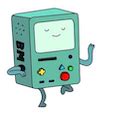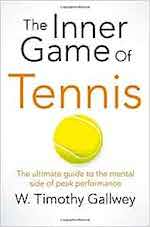Adventure Code

Personal blog
The Inner Game of Tennis - by W. Timothy Gallwey, 1974

The main takeaways of the book:
Almost all human activity is composed of two parts:
- the outer game played against external opponents, facing external obstacle/challenges - to reach external goals
- specific to the situation, different skills needed for every activity
- the inner game, takes place in the mind - played against internal obstacles - habits of the mind that inhibit excellence
- (distraction/lapse of concentration, self-doubt, self-condemnation/judgments, worry/nervousness)
- generic, always the same skills, no matter the activity
- focus, non-judgment, welcoming obstacles/challenges - are a remedy
it makes more sense to focus on the inner game - to play the inner game
as the mental skills we develop can ge generally applied to all ascpects of life
Prioritize Internal Needs vs External demands - to be in sync with yourself and more resilient to stress
- External pressures - demands put on us by other, by society
- sometimes so deeply ingrained we don't even think about questioning them - external validation
- or so authoritative that we are afraid to question them
- Internal desires and needs
- listening to yourself, Self 2, and acting in sync with inner desires
- self-discovery to uncover true inner desires
The two selves
To explain mental processes, let's imagine that each person has two selfes:
Self1 - the teller, the ego-mind, expresses itself verbally - tries to hard, tries to control, is judgemental, always looking for approval and avoiding disapproval
Self2 - the doer, expresses itself through body movements, has a great abilities, good instincts and natural learning capabilities (the human brain and body is a remarkable instrument)
Quieting Self1 - Letting go of judgements
- Judgement is labeling things/actions as "bad"/"good", this leads to ego reactions/emotional reactions (Self 1)
- anger, frustration, discouragement, tightness - which then interferes with concentration and the natural ability of a player (Self 2)
- Letting go of judgement does not mean ignoring errors, just means seeing events as they are, not adding labels to them
- even positive labeling/judgement results in ego-interference, compliments can be seen by the ego-mind as potential criticisms to avoid. Once the standard for "good" and "bad" has been established, even if some event/action was labelled good, it creates an expectation on Self1 to repeat/keep up the same performance or else it will be disliked - looking for external validation
Communication with Self2
- Change the relationship between Self1 and Self2, instead of using the critical tone of Self1 looking down on Self 2, try using a humble admiration towards the natural intelligence and capabilities of Self 2
- The native tongue of Self2 is not words, but sensory imagery: visual image and feelings ("feelmages")
- Observe other players executing strokes, try imagining what does it look and feel like to copy their movements
- Picture the desired outcome: shift attention from means to ends, where do you want the ball to end up, and trust Self 2 - let it happen
Technical Instruction for Tennis
Instructions always originate in a certain experience and feeling of an exceptional athlete, and then words are used to try to communicate those feelings to others
- experience precedes technical knowledge
- words cannot exactly represent these feelings, and so we should always remember to take these instruction only as a guidance to experimenting and finding our own way
- the "standard way" of serving has changed several times in tennis, do to people challenging the instructions and relying on their feelings
Changing habits
- habits - characteristic patterns of acting an thinking - exist because they serve a function
- it is not helpful to condemn a current habit as "bad", it's helpful to identify the function it serves and look for an alternative behavior to serve the same function
- it's difficult to become aware of a function a habit serves, while we are in the process of blaming ourselves
Ways of learning:
- the usual way (Self-1 trap of self-improvement)
- criticize or judge current behavior
- tell yourself to change, instructing with words
- try hard to do it right
- critical judgment of results -> leading to Self1 vicious cycle
i am bad, i need to improve
accepting this self critique and trying to compensate for it - is neither enjoyable nor rewarding
you are good enough, accepting yourself - and look at improvement as an extra activity not something you need to do in order fix yourself
abandoning the ego, stop caring about what other people think
- the inner game way
- observe behavior non-judgmentally (awareness)
- picture desired outcome
- trust Self2, let it happen
- non-judgemental calm observation of results -> leading to continuous observation and learning
Focus & Concentration
- the mind is restless, disturbed
- but to achieve top performance - you need a clear the mind, stop thinking
- this does not mean being stupid, it means quieting the endless jabbering of thoughts so your body can instinctively do what it's been training for
- the thinking mind (Self 1) gets in the way
- how can we learn to be in the present? practice. bringing back attention
- focus on seams of the tennis ball
- sounds of ball impact with floor/racket
- on breath in between plays to not loose focus